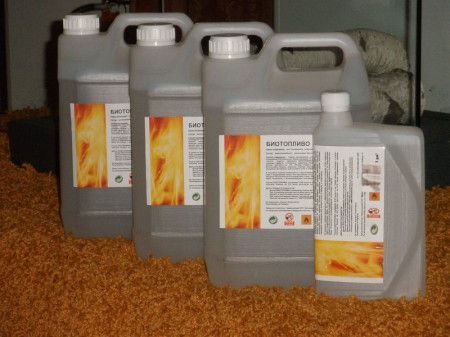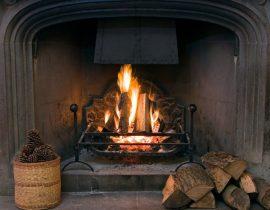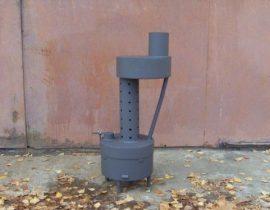With the advent of bio-fireplaces, it became possible to enjoy living fire in a modern city apartment, in which there is no possibility to perform a complex of construction works for the construction of a wood-burning fireplace. The biofireplace consists of a hearth, inside of which a special heating metal block is mounted. Biofuel is poured into this block.

Content
Biofireplace on homemade fuel - video
Biological fuel is understood as a fuel that is obtained from natural (biological) materials, that is, after the processing of natural waste, oils (from rep, palm, etc.), starch-containing and cereal crops. The energy characteristics of biofuels and other fuels are similar.
Types of biofuels:
- bioethanol (gasoline substitute containing alcohol);
- biodiesel (produced from vegetable oils);
- biogas (an analogue of natural gas, which is obtained from waste and garbage that have undergone special treatment).
Bioethanol is used in biofireplaces. Externally, bioethanol is a colorless and odorless liquid.
Biofuel production has been established in a number of European countries (Spain, Germany, France, Italy), North and South America (USA, Canada). The leader in the production of bioethanol is Brazil. Fuel is also produced on the African continent (the leader is South Africa).About five percent of biofuels are produced in India and China.
Video - bioethanol vapor combustion technology
Advantages of bioethanol
- Biofuels are environmentally friendly. In the process of its combustion, there is no emission of soot, soot, smoke or harmful gases.
- The intensity of combustion of biofuels can be controlled.
- Biofuel does not require the installation of hoods or special installations.
- Burners after burning bioethanol are easy to clean.
- Due to the thermal insulation of the body, biofuel fireplaces are fireproof and reliable.
- Bioethanol is easy to transport, and biofuel fireplaces are easy to assemble and dismantle.
- 100% heat transfer (no heat loss to the chimney).
- There is no need to harvest firewood, along with this there is no dirt and debris in the house.
- During the combustion of bioethanol, air is humidified due to water vapor released into the atmosphere.
Description and fuel consumption for biofireplaces
Fuel for biofireplaces is produced in one and a half liter and five liter containers (bottles and plastic canisters).
Bioethanol consumption is about 0.36 liters per hour (1 liter is enough for 2-5 hours).
Efficiency > 95%.
Thermal power (one heating block) 4 kW/h.
Compound
Approximate percentage of substances that make up biofuels:
- bioethanol 96%;
- methyl ethyl ketone 1% (denaturant);
- water 4%;
- bitrex - less than 0.01% (1 gram per 100 liters of fuel).
The process of production of fuel for biofireplaces
- Starch-containing raw materials (cereals) are prepared and crushed.
- Fermentation (starch is decomposed to ethanol using yeast) with recombinant alpha-amylase preparations (glucomylase, amylosubtilin).
- Bragorectification (a process carried out on accelerating columns). After bragorectification, such wastes as fusel oils and stillage remain.
Terms of Use and Precautions
Biofuels are classified as liquids that are very flammable. Respectively, precautionary measures:
- It is forbidden to keep an open container with biofuel near a kindled biofireplace and an open fire;
- It is forbidden to refuel an operating heating burner;
- It is forbidden to use any flammable objects (newspapers, wood, etc.) for ignition.
General rules of operation and safety
- It is necessary to kindle biofuel in the burner with a special lighter;
- If fuel for a biofireplace gets on the floor or other surfaces, it is necessary to wipe the drops with a dry rag;
- It is necessary to store containers with biofuel in a special place, away from open flames and heating devices;
- Refueling of fuel into the burner is carried out after it is turned off and completely cooled down.
How to make fuel for biofireplace do it yourself:
Don't expect much from this method. In addition, with inept handling, the folk method can pose some danger. In any case, before starting work, it is worth taking care of fire safety measures and protecting the skin and organs of vision from chemicals.
For work you will need:
- medical alcohol (from 90 to 96.6 degrees);
- fuel for Zippo lighters (gasoline).
Both of these substances must be mixed (shaking) so that the percentage of gasoline in the volume of finished fuel is 6-10%. The finished composition is poured into cups and set on fire with a lighter.If it is difficult for you to calculate the percentages, you can mix it differently: you need to mix 9 parts of alcohol for 1 part of gasoline. For a measuring cup, you can use any container into which you will pour the necessary ingredients in turn.
A small drawback is the smell of alcohol in the first minutes of burning.
Consumption - 100 ml for 1 hour of burning.













